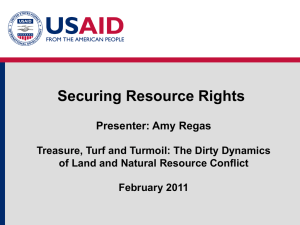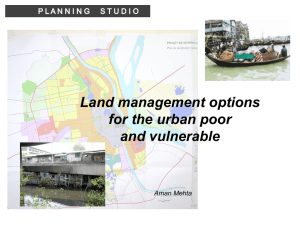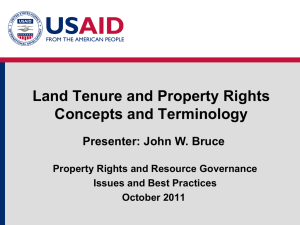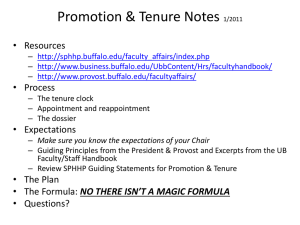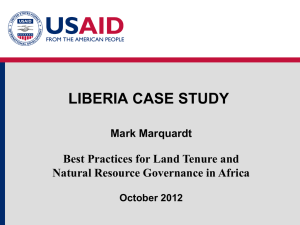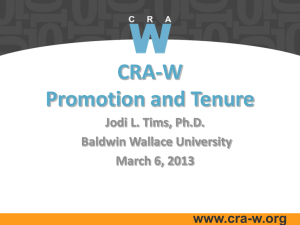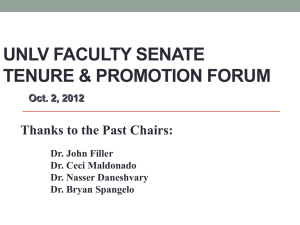Module 1: Concepts and Definitions (Bruce)
advertisement
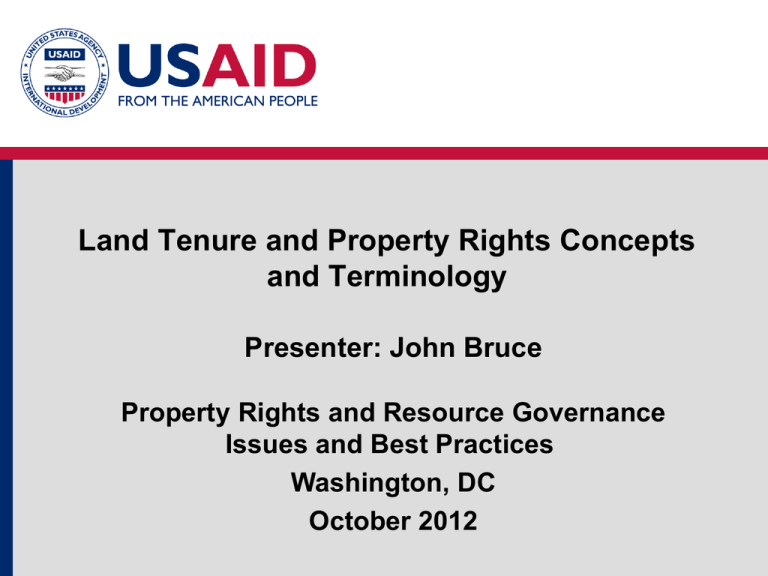
Land Tenure and Property Rights Concepts and Terminology Presenter: John Bruce Property Rights and Resource Governance Issues and Best Practices Washington, DC October 2012 Land in the News Delegates And Government Clash On Customary Land Rwanda: Land Registration Complete What's Behind International Land Grabs? Families in Kacyiru, Kimicanga Areas to Be Expropriated Zimbabwe land reform 'not a failure' 2 Objectives 1. Introduce some fundamental concepts and terms used in the course concerning both issues and interventions in land tenure systems 2. Provide participants with a shared vocabulary of land tenure and property rights 3. Identify a few common confusions in the use of key terms which can lead to miscommunication in policy discussions 3 What is land tenure? 1. Land Tenure and Real Property 2. What’s the point of property rights in land? Avoiding a free-for-all Reducing risks and creating incentives Allowing land to move among users Creating capital - land is a financial asset 4 What is tenure—A bundle of rights 5 What are some basic tenures? 1. Tenures are characterized in terms of: Type of right: ownership (freehold), tenancy (leasehold), usufruct (use right), concession, license Holder: individual (private), state (public), community (common) 2. Tenures are not made in Heaven but are created by law 6 Property regimes Individual property: Strands of property bundle are held by a natural or legal person Community property: Strands are shared among members of a community or association Public (or state) property: Strands are concentrated, held and managed by the government Terra nullius: Land to belongs to no one. Does it exist? 7 What is a tenure system? 1. Includes all the tenures present within a given polity, for example a nation 2. Consists of: Tenures (several bundles of rights and responsibilities which compliment each other) and Institutions (land management/administration), with Connections to larger systems (e.g., economic, political, social systems), which produce certain Results (equity, efficiency, or more narrowly, security, productivity, distribution, marketability, credit access) 3. Most developing countries include several subsystems from different sources 8 What is legal pluralism? How does it work or not work? 1. Validates/protects diversity, culture, identity 2. Co-existing bodies of law may be well or poorly coordinated 3. Tenure systems may be unique or overlapping resulting in confusion and conflict Imagine you are farmer? 1. Parcels may be held under different tenures 2. If systems are poorly coordinated then uncertainty about which system prevails or what authorities are responsible 9 What is customary land tenure? 1. A body of norms generated and enforced by a community to govern the use of land by its members. 2. Best not regarded as informal, because it enjoys social sanction by a polity. An alternative formality. 3. Customary tenure does not = communal tenure. 4. Is it necessarily old and unchanging? 5. Is it insecure? 6. Is it headed for “the trash bin of history”? 7. Strategies: replacement, recognition, adaptation or …? 8. Increased urgency: land market globalization 10 What is common property? 1. A “commons” a communitymanaged resources whose use is shared by members 2. Common property vs. open access resources communal land tenure 3. Two key factors in analysis of common property: Tenure (the group right) Management (institutions) 11 What is security of tenure? Security of Tenure is: Perception of having secure rights to land and property on a continual basis Free from unreasonable interference from outsiders Ability to reap benefits of labor and capital invested, either in use or when leased or rented to another Key Dimensions: Robust rights in the bundle Sufficient duration Inheritability? Marketability? Assurance of protection Questions: Why is tenure security important? Is security of tenure an objective or subjective phenomenon? 12 What is land reform? Type of Reform Reforms that strengthen property rights and security Interventions Land law reform (land tenure reform) Land formalization (titling and registration) Reform of land management/ land administration Reforms that strengthen access Regulatory interventions Redistributive land reform From large private holders, or the state Expropriation or market mechanism Tenancy reform and other law reforms Restitution Resettlement Land use planning Land consolidation 13 What is land formalization? 1. Informality = insecurity? 2. Titling: the state confers a title on an individual in specified land, either by grant or by recognition of a pre-existing right 3. Registration: creation of an official, public record of the right (title registration) or the document creating the right (deed registration) Sporadic: Demand driven, private initiative. Systematic: Policy driven, public initiative. 14 What is “land-grabbing”? (large-scale land acquisition) 1. A pejorative term for large-scale land acquisitions, through concessions or land purchases, that displace existing users. 2. Can involve domestic or foreign actors. While attention often focuses on foreign actors, realization is dawning that domestic acquisitions are often as significant or more significant. 3. Can involve a wide range of purposes: commercial agriculture, conservation (including REDD), biofuels, mining and petroleum exploitation 4. Is a global ‘market’ in land rights developing? 15 Where are large scale acquisitions taking place? Country Projects Area (000 ha) Median Size (ha) Domestic Share Cambodia 61 958 8,985 70 Ethiopia 406 1,190 700 49 Liberia 17 1,602 59,374 7 Mozambique 405 2,670 2,225 53 Nigeria 115 793 1,500 97 Sudan 132 3,965 7,980 78 Data for 2004-09 except for Cambodia and Nigeria which cover 1990-2006. Domestic share is proportion of total transferred area allocated to domestic investors: Source: The World Bank, Rising Global Interest in Farmland, 2011. 16 Points to take away 1. Always query key terms. Does “security of tenure” imply transferability? And what is “private property”? Is it ownership, or may it be something less? 2. “Tagging” a phenomenon can tilt the whole discourse on that phenomenon; e.g., “land-grabbing” 3. Use of politically emotive language confuses matters: A constitution provides: “Land belongs to the people” 4. Statutory definitions complicate matters: e.g.: “In this law, ‘ownership’ means a right to use land for the life of the user.” Pay attention to definitions in statutes. 5. Remember, one man’s “reform” is another’s deform (sic). 17
